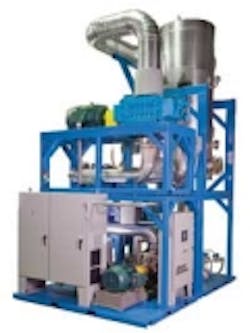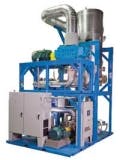High-efficiency filtration drives down water costs at vehicle test facility
BEDFORDSHIRE, UK, June 25, 2009 -- North West based Industrial Purification Systems (IPS) has recently completed the installation of high efficiency media filtration in the vehicle wash facility at one of Europe's leading commercial test and validation centers for the automotive and transportation industries.
Operating a facility that includes every type of land vehicle, from motorcycles and passenger cars to heavy commercial, military and off-road vehicles was impacting heavily on water use, both in terms of cost and the environment. The company was therefore keen to look at ways to minimize this water use and by so doing drive down energy bills and reduce the impact on the environment. However, it didn't want to compromise vehicle wash finish which was an important aspect to its reputable service offer.
Millbrook's vehicle wash facility was using a 2,000-litre flow rate and was encountering high solids concentrations, as well as residual oil and grease. The nature of vehicle wash systems means that particulate solid is extremely small in terms of micron size -- typically down to 1.0 micron. A further issue was a lack of space and limited access to the plant room. IPS's solution was to design a bespoke 4-stage filter and chemical dosing system fabricated around a two-level skid to accommodate the space limitation. The system included chemical dosing pumps, chemical storage tanks, inlet and outlet buffer tanks, first-stage kinetic separators, the CrossFlowMF1.0 and backwash recovery filter, as well as associated pumps and controls. Fabricated in such a way as to enable shipment to site in parts, it was then assembled on site in the plant room.
The key to the system was the CrossFlowMF1.0 technology which crucially allows for the reuse of potable water. This high efficiency media filtration technology removes fine contamination down to 0.45 micron reliably, delivering high quality water at all times. The technology also enables the use of surface water such as rainwater effectively for wash water thereby further reducing overall operational costs.
Andy Evans, specialist engineer at IPS said: "Any large facility that demands the use of high levels of clean water will undoubtedly have an impact on the environment and its energy bills. Yet organizations often see this usage of water as an accepted process cost!
"Having the capability to re-use potable water, or being able to draw on alternative water sources such as borehole and rainwater harvesting, will go along way to provide a sustainable environmental solution and save on energy consumption.
"Most industrial and commercial water sources tested to date show an expected contamination above 20 micron. However, the distribution and population of particulates is consistently higher at less than 20 micron, much of which is biological. Significantly this is even more pronounced below 10 micron which is the traditional cut off point for main stream filtration technologies and is the key reason why a business can lose this 30% in energy performance.
"Until now there has not been a reliable method of filtering out fine contamination. New self-cleaning filtration technology provides a very real solution because it effectively removes contamination to less than 1.0 micron, without the prohibitively high capital/revenue costs normally associated with water polishing applications.
"Our highly efficient water saving and filtration techniques are proven to not only reduce an organizations carbon footprint but to also make huge savings on energy bills. Our systems also allow an organization to maintain the standards they demand in terms of water quality, and the constant need for new resources is greatly diminished, which can only benefit both the environment and a businesses bottom line."
IPS has over 25 years experience in the water filtration business. Its expertise is utilized to eradicate problems in the drinking water and process industries, helping companies to find solutions to some of the most complex production process requirements. Its systems are used in a variety of industries, ranging from food and chemicals processing and manufacturing, to the painting of motor vehicle bodies.
Merseyside-based Industrial Purification Systems specialises in the provision of filtration system solutions for industrial processes. The company has found a natural division into two specific supply chains, including a capital systems division and a consumable filters division. Their sales and distribution network covers the entire UK and Ireland and employs some of the industry's top engineers. Their engineering expertise is utilised in finding solutions to some of the most complex production process requirements.
###

